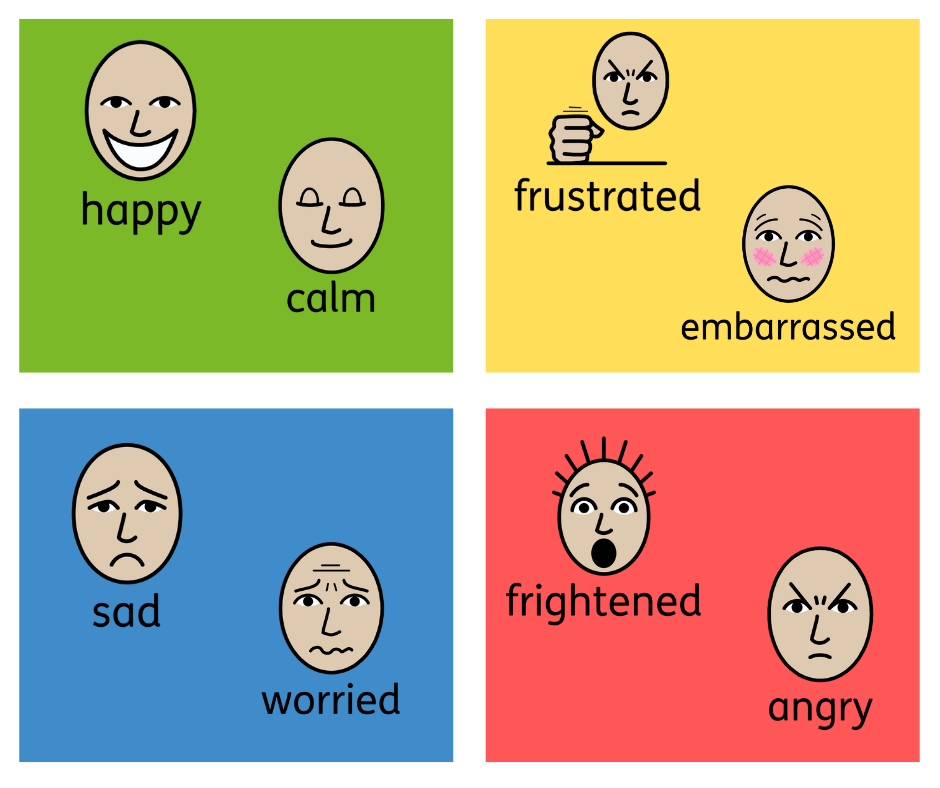Why use colour to categorise emotions?
Understanding emotions can be a difficult task for children, especially those with Down's syndrome, autism, and other learning disabilities. Children with Down's syndrome often struggle with social and emotional development, which can lead to difficulties in forming relationships and interacting with others.
Exploring Emotions
It is crucial to support these children in understanding their emotions and how to regulate them effectively. One approach that has proven effective is using colour zones to group emotions.
We all know that colour coding is a really useful tool in so many areas of life, so this makes complete sense!
Colour zones, such as The Zones of Regulation, are a popular framework used in schools and homes to teach children how to regulate their emotions effectively. This approach categorizes emotions into four colours zones: blue, green, yellow, and red. Each colour zone represents a different emotional state and provides a way for children to identify and express their feelings.
Blue zone represents sad, tired, or bored emotions. Green zone represents calm and happy emotions. Yellow zone represents excited or anxious emotions. And red zone represents intense emotions like anger or frustration. By categorizing emotions into different colours, children can quickly identify how they are feeling and learn how to regulate their emotions effectively.
Emotions in Learning for Life
Watch the ‘Frightened’ video to get a preview of the series. Each Emotions video follows the same structure:
What does the emotion mean? Explanation and synonyms
What emotions look like on the outside
Examples of what might make you feel this emotion
How emotions feel on the inside - introspection
How to feel better and regulate emotions
How does this make a difference?
Supporting non-verbal communication
Our young people often have difficulty with verbal communication. Using colours provides a visual cue that can help them identify and express their emotions, allowing them to understand and communicate their feelings without relying solely on verbal communication.
Building relationships
They often struggle with social interaction and forming relationships. Understanding emotions is a critical component of building relationships and social interaction. By using colour zones to group emotions, children can learn to identify their own emotions and the emotions of others. This approach enables them to build stronger relationships with their peers. Building these skills works alongside those discussed and developed in Learning for Life’s ‘Caring Friendships’ series.
Emotional regulation
Young people often experience challenges with emotional regulation. Emotions can be overwhelming, and children may struggle to regulate their emotional responses effectively. By using colour zones to group emotions, children can learn strategies to regulate their emotions effectively. For example, if a child identifies that they are in the red zone, they can learn strategies to calm down and regulate their emotional response.
Fostering Skills for Life
Using these colour systems, we can categorise different emotions. This is just one way that we are making this learning accessible and specialised for the SEND community. This will complement the work they do in schools and within speech therapy sessions. If you want to see more of our teaching emotions series, simply sign up to the Learning for Life project.
Plus, helping young people to understand their emotions and others means they can form stronger relationships, become more independent, and behave more safely. Developing key social skills like these mean they can grow up to access the world around them better, including social, volunteering, and employment opportunities.
There’s lots more to learn - and Learning for Life is here to help! We now offer teaching around puberty, friendships, relationships, online safety, and much more. All specialised for our community, and all skills-based, we are building a generation of young people ready for adult life. Sign up and access totally free!
Understanding emotions and improving emotional regulation is important for so many more topics in the PSHE curriculum. Sharing healthy friendships and relationships require important elements of emotions, both within ourselves and others. This involves identifying and regulating, and understanding how to make people feel better.
Learn more about the practicalities around teaching emotions in our other blog: Frustrated with Teaching Emotions.



